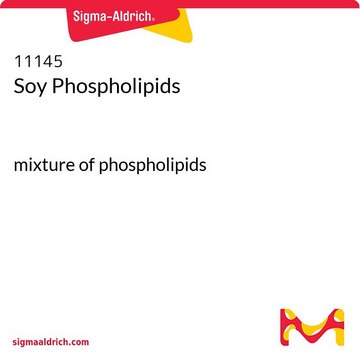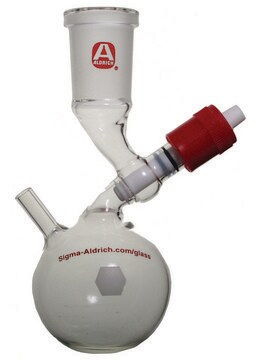840052C
Avanti
Heart PC
Avanti Research™ - A Croda Brand 840052C
Sinonimo/i:
L-α-phosphatidylcholine (Heart, Bovine)
About This Item
Prodotti consigliati
Saggio
>99% (TLC)
Stato
liquid
Confezionamento
pkg of 1 × 2.5 mL (840052C-25mg)
pkg of 2 × 4 mL (840052C-200mg)
pkg of 5 × 4 mL (840052C-500mg)
Produttore/marchio commerciale
Avanti Research™ - A Croda Brand 840052C
Concentrazione
10 mg/mL (840052C-25mg)
25 mg/mL (840052C-200mg)
25 mg/mL (840052C-500mg)
Tipo di lipide
phosphoglycerides
phospholipids
Condizioni di spedizione
dry ice
Temperatura di conservazione
−20°C
Stringa SMILE
[P](=O)([O-])(OC[C@H](OC(=O)CCCCCCC\C=C/C\C=C/CCCCC)COC(=O)CCCCCCCCCCCCCCC)OCC[N+](C)(C)C
InChI
1S/C42H80NO8P/c1-6-8-10-12-14-16-18-20-21-23-25-27-29-31-33-35-42(45)51-40(39-50-52(46,47)49-37-36-43(3,4)5)38-48-41(44)34-32-30-28-26-24-22-19-17-15-13-11-9-7-2/h14,16,20-21,40H,6-13,15,17-19,22-39H2,1-5H3/b16-14-,21-20-/t40-/m1/s1
JLPULHDHAOZNQI-ZTIMHPMXSA-N
Descrizione generale
Applicazioni
Azioni biochim/fisiol
Confezionamento
Note legali
Avvertenze
Danger
Indicazioni di pericolo
Classi di pericolo
Acute Tox. 3 Inhalation - Acute Tox. 4 Oral - Carc. 2 - Eye Irrit. 2 - Repr. 2 - Skin Irrit. 2 - STOT RE 1 Oral - STOT SE 3
Organi bersaglio
Liver,Kidney, Respiratory system
Codice della classe di stoccaggio
6.1D - Non-combustible acute toxic Cat.3 / toxic hazardous materials or hazardous materials causing chronic effects
Classe di pericolosità dell'acqua (WGK)
WGK 3
Punto d’infiammabilità (°F)
does not flash
Punto d’infiammabilità (°C)
does not flash
Scegli una delle versioni più recenti:
Certificati d'analisi (COA)
It looks like we've run into a problem, but you can still download Certificates of Analysis from our Documenti section.
Se ti serve aiuto, non esitare a contattarci Servizio Clienti
Possiedi già questo prodotto?
I documenti relativi ai prodotti acquistati recentemente sono disponibili nell’Archivio dei documenti.
Il team dei nostri ricercatori vanta grande esperienza in tutte le aree della ricerca quali Life Science, scienza dei materiali, sintesi chimica, cromatografia, discipline analitiche, ecc..
Contatta l'Assistenza Tecnica.![C11 TopFluor™ Galactosyl Ceramide N-[11-(dipyrrometheneboron difluoride)undecanoyl]-D-galactosyl-β1-1′-D-erythro-sphingosine, powder](/deepweb/assets/sigmaaldrich/product/images/246/046/3bdfc7ea-d7b5-45cf-b4d0-b7f21ea91875/640/3bdfc7ea-d7b5-45cf-b4d0-b7f21ea91875.jpg)










